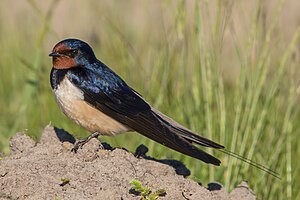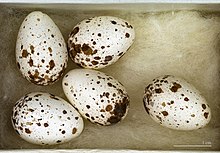Barn swallow
| Barn swallow | ||||||||||||
|---|---|---|---|---|---|---|---|---|---|---|---|---|

Barn swallow ( Hirundo rustica ) |
||||||||||||
| Systematics | ||||||||||||
|
||||||||||||
| Scientific name | ||||||||||||
| Hirundo rustica | ||||||||||||
| Linnaeus , 1758 |
The Barn Swallow ( Hirundo rustica ), also house swallow and fork Schwalbe called, is a bird art from the family of swallows (Hirundinidae). She is a migratory bird .
description
Appearance
The barn swallow is about 19 to 22 centimeters long, of which two to seven centimeters are accounted for by the tail skewers. The weight during the breeding season is between 16.1 and 21.4 grams for males, while females weigh between 16 and 23.7 grams. The wing span is 32 to 34.5 cm.
The barn swallow is very slender with a characteristic deeply forked and long tail. The back is metallic shiny blue-black. The underside is creamy white. The chestnut brown color on the throat, which is completely framed in black, as well as on the forehead and chin is also characteristic. There are white spots on the tail feathers, which can be seen when the tail is spread.
Flight image and airspeed
The flight of the barn swallow is compared with that of the House Martin tearing. A barn swallow flies at 10–20 m / s with 4–10 wing beats per second. The wing beat frequency of the barn swallow averages 4.4 beats per second and is thus slower than that of the house martin with 5.3 beats per second. Basically, the barn swallow hunts deeper in the air than the house martin. Barn swallows hunt most of their prey at an altitude of seven to eight meters.
voice
The reputation is a high "wid wid". The singing is performed in flight and also by waiting and is a rapidly flowing, melodic chirping of many overtone-rich and some buzzing elements.
Habitat and Distribution
The species lives in the open cultural landscape , where there are farms , meadows and ponds . The animals spend the summer in their breeding areas between April and September or the beginning of October. These can be found all over Europe , Northwest Africa , the temperate areas of Asia and North America up to an altitude of around 1000 meters and up to the Arctic Circle . The European barn swallows overwinter in Central and South Africa. There are Asian winter quarters in India and Iran .
nutrition
Barn swallows hunt all kinds of flying insects . In doing so, they orient themselves to the local offer and look for the regions in the air that offer the cheapest offer according to the weather. When they hunt together with house martins , it is in the air space below them.
Multiplication
Mating game
The males of the North American barn swallow court the favor of a female with their reddish, maroon feathers on their throats. The more intensely their feather colors shine there, the greater their mating success with the females. After the pairing game, permanent pair bonds basically result.
Pair formation
Irrespective of the principle of pair formation , the females occasionally mate with other males and it has been proven by DNA studies that there are always eggs in the clutches that have been fertilized by a male other than the steady partner.
With regard to the mating game and pair formation in North American barn swallows, the American biologist Rebecca Safran from Cornell University in Ithaca , New York , (USA) has shown that, despite a permanent pair bond, the males have to impress their partners again and again. Before each breeding season, the females seem to reassess their partner's qualities. If your previous male does not look good in comparison to another, they may put significantly more "cuckoo eggs" in their husband's nest. This means that the females of the North American barn swallows constantly observe their males very closely, react quickly to changes in the appearance of their partners and for them the mating game is ultimately never over.
Brood
For breeding and rearing the young, the barn swallow builds open, bowl-shaped nests made of clumps of mud and straw on a protruding wall or beams on the wall in stables or barns and other open interiors. In earlier centuries they often flew in and out through the openings in the gable, through which the smoke from the hearth fire also escaped. So they got the name barn swallows. As they are excellent fliers, a tilted window is sufficient for them to leave the building. The nests are used over and over again. There the female lays four to five white, brownish-red spotted eggs two to three times a year, which it incubates for 14 to 17 days. Both parents feed for 20 to 22 days after hatching and the young leave the nest for the first time at this age. It is interesting that the older young help feed the second brood.
Danger
The barn swallow is classified as endangered in category 3 in the Red List of Germany's breeding birds from 2015, as well as in the Red List of Lower Saxony and Bremen since 2015.
Others
The barn swallow was bird of the year in Germany in 1979 and bird of the year in Switzerland in 2004 .
The barn swallow is the national bird of Estonia .
The barn swallow is part of the company emblem of the Chinese airline China Eastern Airlines .
literature
- Arnold von Vietinghoff-Riesch : The Barn Swallow. Duncker & Humblot, Berlin 1955.
- Hans-Günther Bauer, Einhard Bezzel and Wolfgang Fiedler (eds.): The compendium of birds in Central Europe: Everything about biology, endangerment and protection. Volume 2: Passeriformes - passerine birds. Aula-Verlag Wiebelsheim, Wiesbaden 2005, ISBN 3-89104-648-0 .
Web links
- Building instructions for a barn swallow nest box
- Singing barn swallow at www.vogelstimmen-wehr.de
- Hirundo rustica in the endangered Red List species the IUCN 2008. Posted by: BirdLife International, 2008. Accessed January 31 of 2009.
- Videos, photos and sound recordings on Hirundo rustica in the Internet Bird Collection
- Age and gender characteristics (PDF; 2.3 MB) by Javier Blasco-Zumeta and Gerd-Michael Heinze (English)
- Barn swallow feathers
Individual evidence
- ↑ Felix Liechti, Bruderer, Lukas: Wingbeat frequency of barn swallows and house martins: a comparison between free flight and wind tunnel experiments . In: The Company of Biologists (Ed.): The Journal of Experimental Biology . 205, 2002, pp. 2461-2467.
- ^ Turner, p. 166
- ^ Turner, p. 227
- ^ Safran, RJ, CR Neuman, KJ McGraw, and IJ Lovette: Dynamic paternity allocation as a function of male plumage color in barn swallows , in: Science, 309: 2210-2212, 2005
- ↑ Christoph Grüneberg, Hans-Günther Bauer, Heiko Haupt, Ommo Hüppop, Torsten Ryslavy, Peter Südbeck: Red List of Germany's Breeding Birds , 5 version . In: German Council for Bird Protection (Hrsg.): Reports on bird protection . tape 52 , November 30, 2015.
- ↑ Thorsten Krüger, Markus Nipkow: Red List of Endangered Breeding Birds in Lower Saxony and Bremen, 8th version, as of 2015 . Ed .: Lower Saxony State Agency for Water Management, Coastal Protection and Nature Conservation. tape 35 , no. 4 . Hanover April 2015, p. 195 .
- ↑ Bird of the Year (Germany): 1979
- ↑ Bird of the Year (Switzerland): 2004






